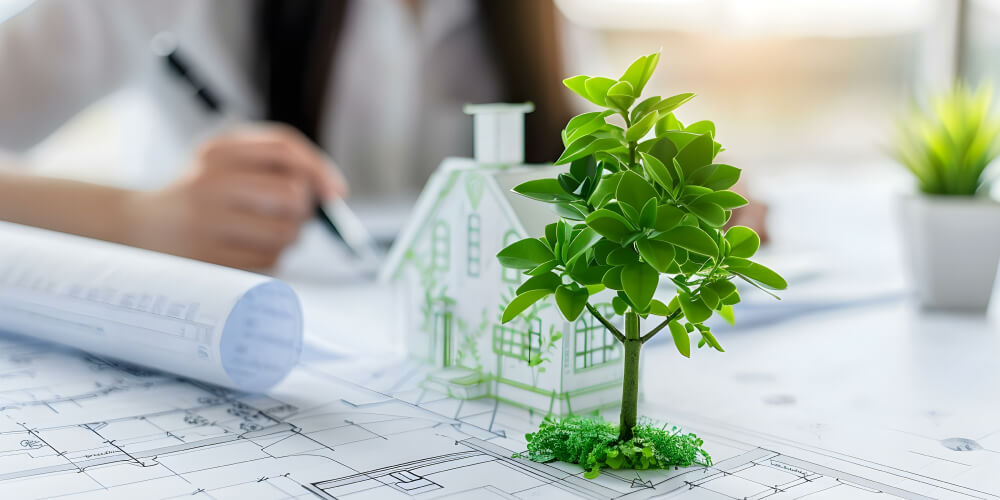1. Benefits of Green Roofing
Environmental Benefits:
- Energy Efficiency: Green roofs provide excellent insulation, reducing the need for heating in the winter and cooling in the summer. This results in lower energy consumption and reduced utility bills.
- Air Quality Improvement: Vegetation on green roofs helps filter pollutants and carbon dioxide from the air, contributing to better air quality.
- Stormwater Management: Green roofs absorb rainwater, reducing runoff and the risk of flooding. This helps manage stormwater more effectively and reduces the burden on sewer systems.
Economic Benefits:
- Increased Property Value: Homes with green roofs often have higher property values due to their aesthetic appeal and energy efficiency benefits.
- Extended Roof Lifespan: Green roofs protect the underlying roof materials from UV radiation and extreme temperatures, extending the lifespan of the roof.
- Energy Savings: The insulation properties of green roofs reduce energy costs, leading to long-term savings on utility bills.
Health and Well-Being:
- Urban Heat Island Effect: Green roofs help mitigate the urban heat island effect by cooling the surrounding environment, making cities more comfortable during hot weather.
- Biodiversity: Green roofs provide habitats for various plant and animal species, promoting biodiversity in urban areas.
- Aesthetic and Recreational Space: Green roofs create pleasant green spaces that can be used for relaxation and recreation, improving mental well-being.
2. Types of Green Roofing
Extensive Green Roofs:
- Lightweight and Low Maintenance: Extensive green roofs have a shallow growing medium (2-6 inches) and support low-growing, drought-resistant plants such as sedum and grasses.
- Ideal for Retrofit Projects: Due to their lightweight nature, extensive green roofs are suitable for retrofitting existing buildings.
Intensive Green Roofs:
- Deeper Soil and Diverse Vegetation: Intensive green roofs have a deeper growing medium (6 inches to several feet) and can support a wide variety of plants, including shrubs and small trees.
- More Maintenance Required: These roofs require regular maintenance, including irrigation, fertilization, and pruning.
Semi-Intensive Green Roofs:
- Combination of Both Types: Semi-intensive green roofs fall between extensive and intensive roofs in terms of soil depth and vegetation variety.
- Balanced Maintenance and Benefits: They offer a balance between the low maintenance of extensive roofs and the diverse planting options of intensive roofs.
Join HICP Homeowner’s Alliance
Connect with experts, get special discounts and enjoy member benefits
3. Installation Tips for Green Roofing
Structural Assessment:
- Professional Evaluation: Before installing a green roof, hire a structural engineer to assess whether your roof can support the additional weight of the green roof system.
- Load-Bearing Capacity: Ensure the building can handle the combined weight of the soil, plants, and water, especially during heavy rainfall.
Waterproofing and Drainage:
- High-Quality Waterproof Membrane: Install a high-quality waterproof membrane to protect the roof structure from water damage.
- Effective Drainage System: Incorporate an effective drainage system to prevent waterlogging and ensure excess water can drain away efficiently.
Root Barrier:
- Prevent Root Penetration: Install a root barrier to prevent plant roots from penetrating and damaging the waterproof membrane and roof structure.
Growing Medium:
- Suitable Soil Mix: Use a lightweight, well-draining soil mix specifically designed for green roofs. This mix should provide adequate nutrients and support plant growth.
- Soil Depth: Ensure the soil depth is appropriate for the type of vegetation you plan to grow.
Plant Selection:
- Drought-Resistant Plants: Choose drought-resistant plants that can thrive with minimal irrigation. Native plants are often a good choice as they are adapted to local climate conditions.
- Variety for Biodiversity: Include a variety of plants to promote biodiversity and create a visually appealing green roof.
Irrigation System:
- Automatic Irrigation: Install an automatic irrigation system to provide consistent moisture during dry periods. Drip irrigation systems are efficient and effective for green roofs.
- Water Conservation: Use rainwater harvesting systems to collect and reuse rainwater for irrigation.
Maintenance Plan:
- Regular Inspections: Conduct regular inspections to check for any issues such as drainage blockages, plant health, and membrane integrity.
- Seasonal Care: Perform seasonal maintenance tasks, including weeding, pruning, and fertilizing, to keep the green roof healthy and thriving.
4. Choosing the Right Green Roofing Professional
Research and References:
- Experience and Expertise: Choose a contractor with experience in installing green roofs. Check their references and portfolio of completed projects.
- Certifications: Look for certifications such as Green Roof Professional (GRP) certification, which indicates specialized knowledge and skills in green roof installation.
Detailed Proposal:
- Comprehensive Plan: Request a detailed proposal that outlines the scope of work, materials to be used, timeline, and cost estimate.
- Warranty and Maintenance: Ensure the proposal includes information about warranties on materials and workmanship, as well as a maintenance plan.
Local Regulations and Permits:
- Compliance: Ensure the project complies with local building codes and regulations. Obtain necessary permits before starting the installation.
Green roofing options offer numerous benefits, including improved energy efficiency, enhanced air quality, effective stormwater management, and increased property value. By choosing the right type of green roof, conducting thorough planning and assessment, and working with experienced professionals, you can successfully install a green roof that provides long-term benefits for your home and the environment. Embrace green roofing to create a more sustainable and aesthetically pleasing living space.




















